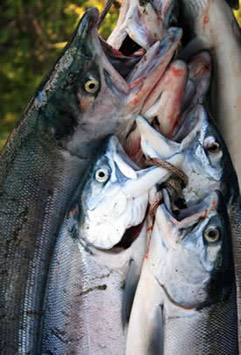
Kenai (RM 19) River
Fish
The Fish
The Kenai River provides habitat for 40 unique species of fish including four species of salmon—sockeye, king, coho and pink salmon—and is by far the biggest producer of sockeye salmon in Upper Cook Inlet.
There are two sockeye salmon runs into the Kenai River, an early run and larger late run. The early run migrates to the Russian River—a clearwater tributary of the Kenai River, while the late run migrates into streams and lakes throughout Kenai drainage. The Department of Fish and Game developed the Kenai River sockeye salmon sonar site project to produce inriver estimates for the river’s late-run sockeye salmon. The late run enters the lower river in early July, peaks in late July and ends between mid and late August.The peak of the run generally lasts seven to 10 days. During the peak, is not uncommon to see sonar estimates of more than 20,000 fish per day. In 2011, an estimated 230,000 fish entered the river in a single day.
Fishing
Kenai River sockeye stocks are among the most heavily fished in Alaska. Commercial harvests have averaged almost 2.5 million Kenai sockeye salmon per year over the last 20 years. Sport and personal use fisheries also heavily fish Kenai sockeye salmon. Sport fishermen harvested an average of 174,631 sockeye salmon per year from 1981 to 2009, with harvests ranging from 15,702 to 308,850 fish per year. Personal use fishermen harvested an average of 235,774 sockeye salmon per year from 2000 to 2010, with harvests ranging from 98,262 in 2000 to 389,552 in 2010.
Kenai River late-run sockeye salmon management
Kenai River late-run sockeye salmon are managed under the Kenai River Late-Run Sockeye Salmon Management Plan. The plan directs ADF&G to manage the salmon primarily for commercial uses while providing sport fisheries with reasonable harvest opportunities. Under the plan ADF&G must also meet Kenai River late-run sockeye salmon escapement and inriver goals, while minimizing the commercial harvest of Northern District and Kenai River coho salmon and late-run Kenai River king salmon.
The Kenai River late-run sockeye salmon are managed according to three types of goals—a Sustainable Escapement Goal (SEG), an Optimum Escapement Goal (OEG) and a three-tiered Inriver Goal. The SEG is 700,000 to 1.2 million fish and the OEG is 700,000 to 1.4 million fish. There are three possible Inriver Goals depending on the projected strength of the run.
| Ranges of projected run strength and corresponding Inriver Goals (number of fish needed past the sonar) | |
|---|---|
| If the projected strength of the runs is... | Then the Inriver Goal becomes... |
| Less than 2.3 million fish | 900,000 to 1.1 million sockeye salmon |
| 2.3 to 4.6 million fish | 1 million to 1.3 million sockeye salmon |
| Greater than 4.6 million fish | 1.1 million to 1.5 million sockeye salmon |
The ADF&G Division of Commercial Fisheries operates the Kenai River Mile 19 sockeye salmon sonar site and is responsible for managing Upper Cook Inlet commercial fisheries to achieve the inriver goal. The ADF&G Division of Sport Fisheries is responsible for assessing inriver harvests and, when necessary, issuing emergency orders to restrict or liberalize the sport harvest to achieve the OEG.



